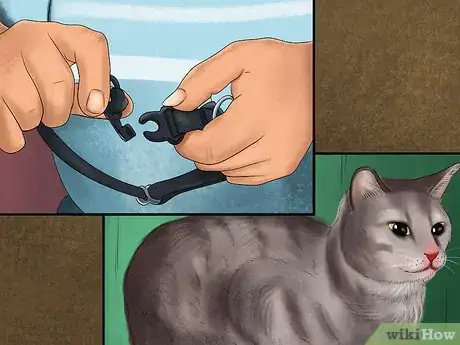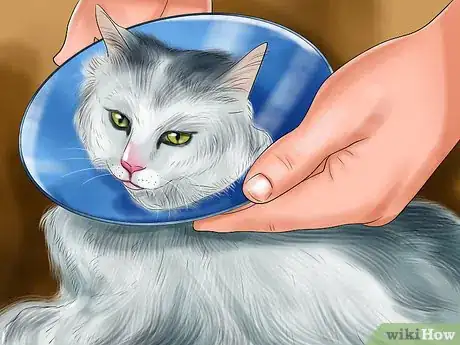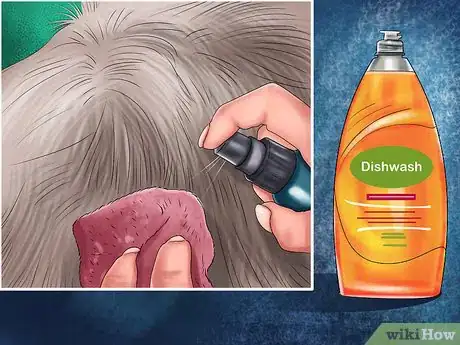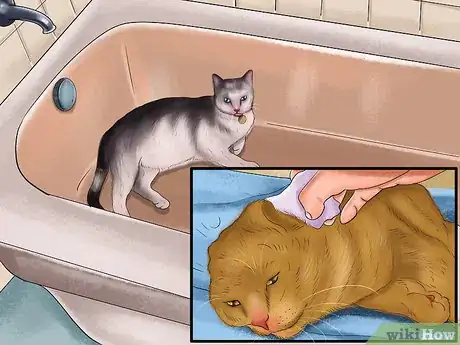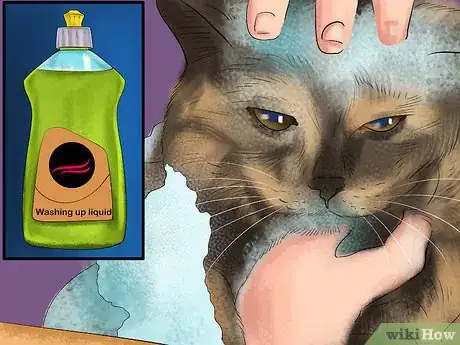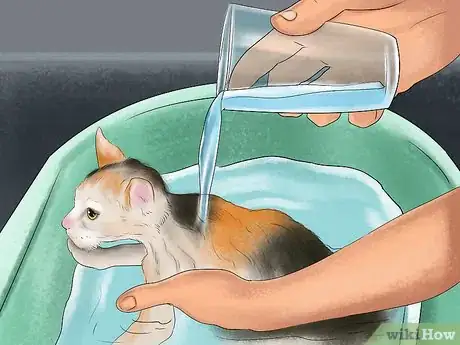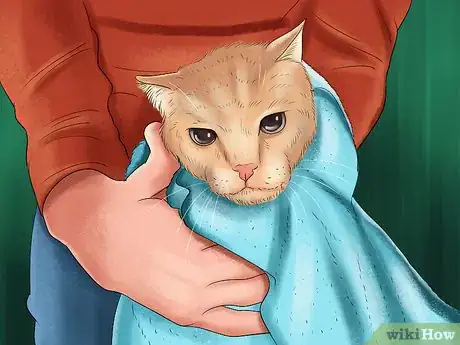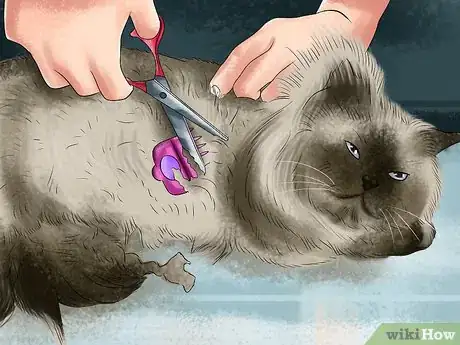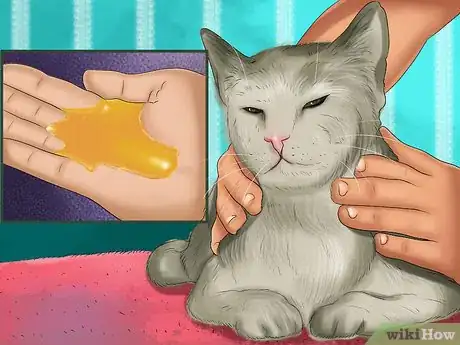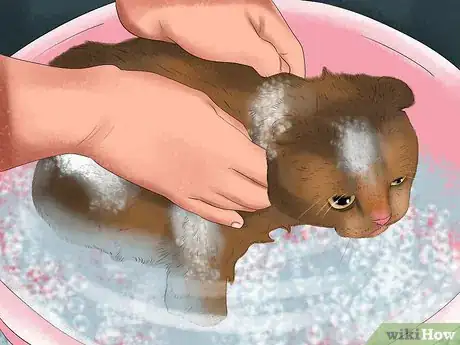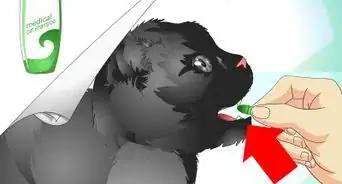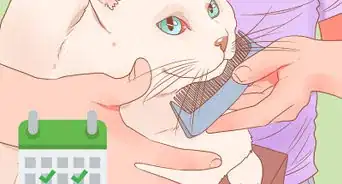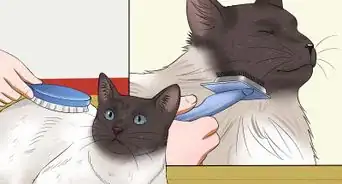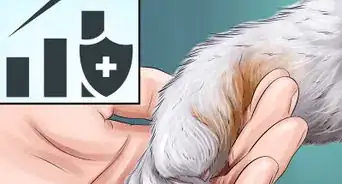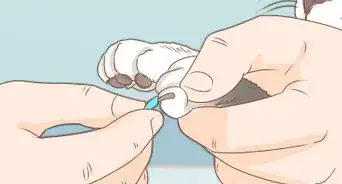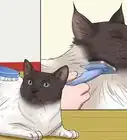This article was co-authored by Melissa Nelson, DVM, PhD. Dr. Nelson is a Veterinarian who specializes in Companion and Large Animal Medicine in Minnesota, where she has over 18 years of experience as a veterinarian in a rural clinic. She received her Doctor of Veterinary Medicine from the University of Minnesota in 1998.
There are 11 references cited in this article, which can be found at the bottom of the page.
This article has been viewed 66,261 times.
Cats have a tendency to get into everything, including paint. If your cat has paint on their fur, it is important that you remove it as soon as possible to prevent skin irritation and poisoning. Before you begin, secure the cat, and make sure that they cannot lick themselves while you prepare to remove the paint. Water-based paints, such as latex and tempera, can be removed with a simple bath. If your cat has an oil-based paint on their fur, you will need to either trim the fur or treat it with cooking oil before bathing.
Steps
Reducing the Risk of Poisoning
-
1Remove their collar. If their collar also has paint on it, remove it, and wash it separately. You can use oil to remove oil-based stains or wash it with dish soap to remove water-based paint. Let it dry completely before putting it back on your cat. If the paint has soaked through the cat’s collar, particularly if it is an oil-based paint, you may want to simply throw the collar away.
-
2Supervise them until you can clean them. You will need to make sure that your cat does not lick their fur until you have safely removed the paint. This means that someone must be watching the cat until you are able to clean them. If you notice the cat trying to lick themselves, stop them.[1]
- Try putting an Elizabethan collar on your cat. This is a plastic cone that your cat can wear around their neck to prevent them from licking the paint. Do not remove the collar or let your cat outside until you have safely removed all of the paint.
- If you do not have a collar readily available, you can wrap the cat in a towel instead.[2]
Advertisement -
3Go the vet if you think your cat has consumed the paint. Most varieties of paint are toxic to cats, and cats may try to lick the paint off of themselves. Before you do anything, make sure that the cat has not ingested any paint. If you’re unsure, visit the vet just in case.[3] Some symptoms of poisoning in cats includes:
- Problems breathing
- Diarrhea or vomiting
- Drooling
- Fever
- Head shaking
- Pawing at the mouth
- Seizures
- Bluish gums and tongue
Washing out Water-Based Paint
-
1Remove small spots. If the spot is small or limited to one area, you may be able to remove it without bathing the cat entirely. Wet the fur by pouring a small cup of water over the spot. You can also dampen it with a wet washcloth. Rub dish soap into the spot. Rinse out by pouring more water over the paint until it has been removed entirely. Towel dry the cat.
- Hold the cat firmly with one hand to keep them still while you clean. If possible, have another person hold the cat while you wash them.[4] If the cat tries to escape, gently pull them back.
- If the cat tries to wriggle away or scratch you, you may need to restrain them with a towel. Wrap the towel around their feet and body. Try to leave the painted areas unwrapped so that you can wash off the paint.[5]
-
2Prepare a bath. If your cat is covered with multiple paint stains or if the mess is extensive, you may need to prepare a full bath. Fill a bathtub or sink with a few inches of warm water. As you bring your cat to the bath, pet them and talk to them soothingly.
- If you have a sink with a spray nozzle, you do not need to fill the sink, but rather, you can use the spray nozzle to wet and rinse them.[6]
- Put some cotton in the cat’s ears before placing them in the bath to prevent water from going inside.
- Placing a towel or rubber bath mat on the bottom of the basin can help prevent your cat from slipping.[7] This will also give them something to grip onto if they are nervous during the bath.
- If you’re worried about being scratched, you may want to trim their nails before you bathe them.
-
3Rub dish soap into their fur. Once the cat is in the bath, wet them by pouring or spraying water over their body. Do not try to wash their head or face. Take the dish soap or a cat shampoo, and massage it into the cat’s fur.[8] The paint should start coming loose and running off at this point.
- Do not use human shampoo, as this can irritate the cat’s skin.
- Do not use any soap on the cat’s head or face. If there is paint on the cat’s head or face, try to gently remove it with a damp wash cloth.[9]
-
4Rinse out the soap. Take a cup or pitcher, and fill it with water from the bath. Starting with the neck behind your cat’s head and moving towards their tail, pour the water over their body. Try not to get the cat’s head wet. Do this a few times until all of the soap and the paint has been rinsed from their fur.
- If you have a spray nozzle, you can simply run the water over the cat’s fur.
- If paint still remains after you rinse, try reapplying the dish soap, and wash them a second time.
-
5Dry the cat with a towel. Once the cat is clean, remove them from the bath, and wrap them in a towel immediately. Soak up as much as water as you can with the towel. If you want, you can set a hairdryer to its lowest heat and air settings. Gently blow the cat dry.[10]
Cleaning Oil-Based Paint
-
1Trim off the paint. If your cat only has a few, targeted spots on their fur, trimming is the easiest way to remove it. Let the paint harden first. Using a pair of nail scissors, gently cut the paint patches away. Try to remove as much of the paint from the cat’s fur as possible.[11]
- If you manage to trim off all of the paint, you do not need to do anything else.
- Be careful not to cut too close to the cat’s skin. If you are having difficulty trimming the fur or if your cat is wiggling, you may want to skip to using oils to remove the paint.
-
2Rub cooking oil into the paint. If the paint is deep into the cat’s fur or if it covers a larger spot, you can use vegetable or mineral oils to get it out. Pour a little into your hand, and work it into the paint spots.[12] Use a paper towel to pat out excess oil.[13]
- It may take a few tries to get all of the paint out. Keep rubbing in oil and gently patting it away until all of the paint is removed.
- Do not use turpentine or harsh paint removers. These can burn and irritate a cat's skin.
-
3Bathe your cat. The oil will loosen and help you remove most of the paint by hand. That said, you should bathe your cat after this process to make sure that all of the oil and paint is gone.[14] Run a lukewarm bath, and wash the cat with a cat shampoo. Towel dry afterwards.
Warnings
- Never use harsh paint-removing chemicals, such as turpentine or mineral spirits. These can cause burns or severe skin irritation.⧼thumbs_response⧽
- Cats can be poisoned if they consume or lick paint. Take your cat to the vet immediately if you suspect or worry that this has happened.⧼thumbs_response⧽
References
- ↑ http://www.vetstreet.com/our-pet-experts/7-spring-home-fixer-upper-hazards-for-pets
- ↑ https://vcahospitals.com/know-your-pet/paint-and-varnish-poison-alert-for-dogs-and-cats
- ↑ https://vcahospitals.com/know-your-pet/paint-and-varnish-poison-alert-for-dogs-and-cats
- ↑ http://www.vetstreet.com/our-pet-experts/why-does-my-cat-hate-to-take-baths
- ↑ http://www.vetstreet.com/our-pet-experts/towel-wrap-your-cat-in-5-scratch-free-steps
- ↑ https://www.youtube.com/watch?v=W835QHC6Q8o&feature=youtu.be&t=65
- ↑ https://www.aspca.org/pet-care/cat-care/cat-grooming-tips
- ↑ https://www.youtube.com/watch?v=W835QHC6Q8o&feature=youtu.be&t=65
- ↑ https://www.aspca.org/pet-care/cat-care/cat-grooming-tips
About This Article
To remove water-based paint from a cat's fur, wet its fur where the paint is, and rub some dish soap into the paint until it's all gone. For larger areas of paint, you may need to give your cat bath. To get oil-based paint out of your cat's fur, try using a pair of nail scissors to trim the paint off. Or, for larger areas of paint, rub cooking oil into your cat's fur until the paint comes out. If you think your cat may have ingested any of the paint, take it to see a vet as soon as possible. For more advice from our Veterinary co-author, like how to give your cat a bath, scroll down!
